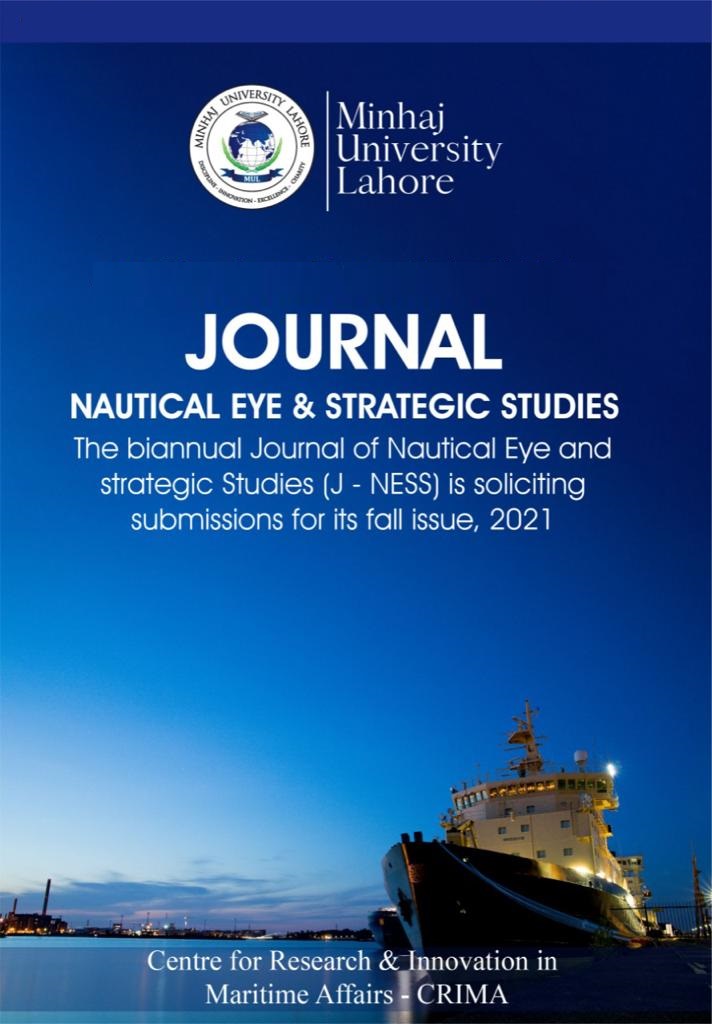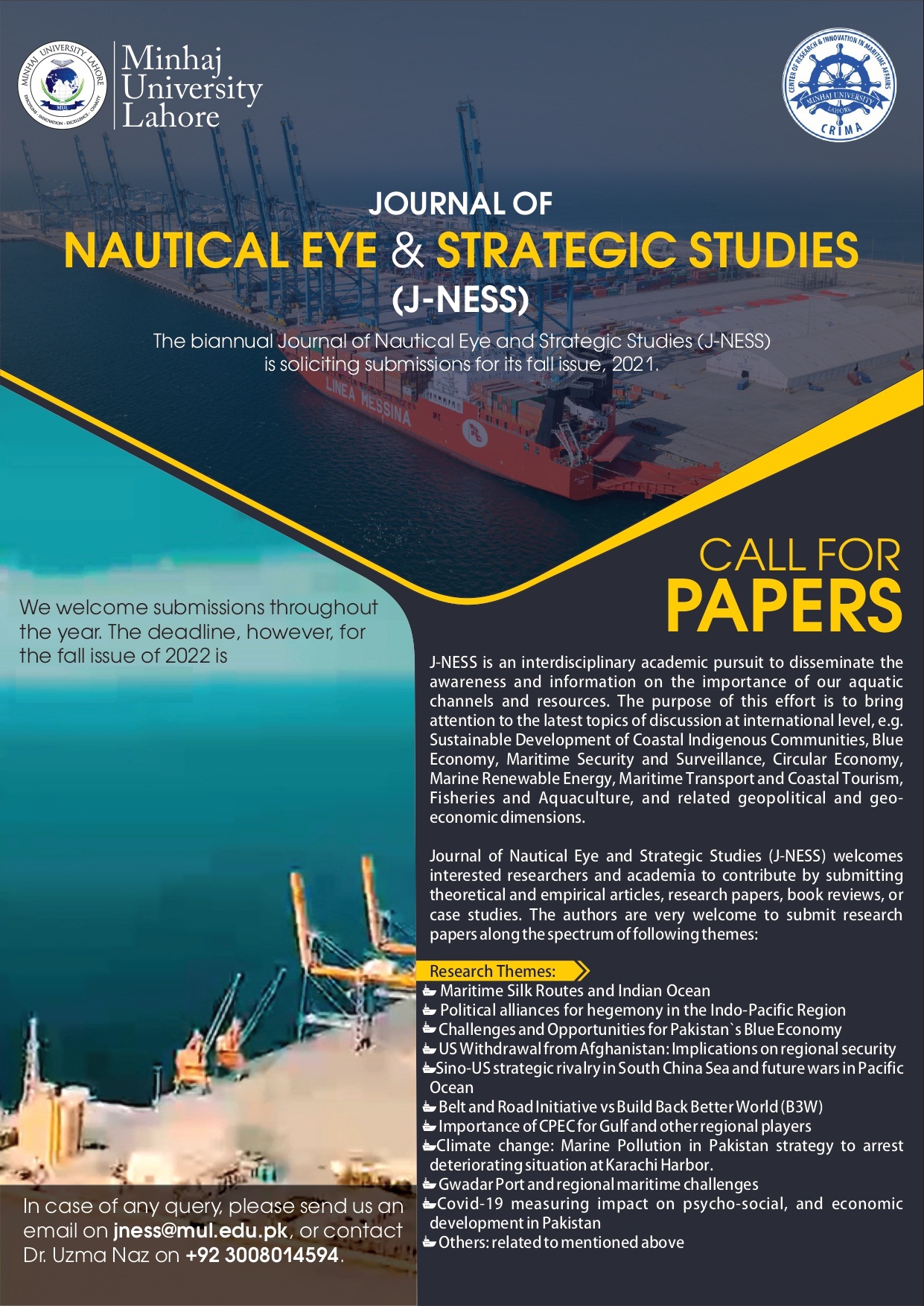A Sino-US Strategic Competition in the Indian Ocean Region: A Critical Analysis
DOI:
https://doi.org/10.58932/MULG0053Keywords:
Indian Ocean Region, Sino-US Rivalry, Strategic Competition, Indo-Pacific Strategy, Maritime SecurityAbstract
This article critically examines the intensifying strategic rivalry between the United States and China in the Indian Ocean Region (IOR). Anchored in Realist Security Theory, the study explores the geopolitical, military, and economic dimensions of Sino-US competition, focusing on strategic interests, military posturing, maritime security, and infrastructure-based economic engagements such as the Belt and Road Initiative (BRI) and the U.S.-led Indo-Pacific Strategy. Employing a qualitative methodology enriched by case studies of key regional nodes Gwadar Port, Djibouti, and Diego Garcia the research evaluates the impact of great power rivalry on regional stability and state autonomy. The paper also reviews policy responses by regional actors and outlines future scenarios, offering policy recommendations for mitigating conflict while maintaining regional balance and sovereignty.
References
Acharya, A. (2019). Constructing global order: Agency and change in world politics. Cambridge: Cambridge University Press.
Brewster, D. (2014). India’s ocean: The story of India’s bid for regional leadership. England: Routledge.
Bhatti, M. B. A., & Khan, M. K. (2024). Implications of Project Managers’ Competencies on Project Success Moderating effect of Project Risk Management: A case of IT Sector in Lahore. Pakistan Journal of Multidisciplinary Research, 5(1), 66-85.
Brewster, D. (2020). India and China at sea: Competition for naval dominance in the Indian Ocean. Oxford University Press.
Buzan, B., Waever, O., & de Wilde, J. (1998). Security: A new framework for analysis. Lynne Rienner Publishers.
Chaturvedi, S., & Mohanty, S. K. (2018). China’s Belt and Road Initiative: Analysis and implications (RIS Discussion Paper #232). Research and Information System for Developing Countries.
Colley, C. (2020). Strategic competition in the Indian Ocean: Australia’s Indo-Pacific pivot. Journal of Indo-Pacific Affairs, 3(4), 12–29.
Chughtai, M. A., Bhatti, M. B. A., & Naqvi, I. H. Ethics before Trust in Organization Public Relationships (OPRs): A Review of Real Estate Organizations.
Downs, E. S., Becker, J., & deGategno, P. B. (2017). China’s military support facility in Djibouti: The economic and security dimensions of China’s first overseas base. CNA Analysis and Solutions.
Dutton, P. A. (2011). Military activities in the EEZ: A U.S.-China dialogue on security and international law in the maritime commons. U.S. Naval War College, China Maritime Studies Institute.
Erickson, A. S., & Goldstein, L. J. (2009). China’s future nuclear submarine force: Insights from Chinese writings. Naval War College Review, 62(1), 55–79.
Erickson, A. S., & Strange, A. M. (2014). No substitute for experience: Chinese antipiracy operations in the Gulf of Aden. Naval War College Review, 67(1), 11–41.
Erickson, A. S., & Strange, A. M. (2017). China’s blue soft power: Antipiracy, engagement, and image-building in the Gulf of Aden. Naval War College Review, 70(1).
Faridi, S. (2024). China’s ports in the Indian Ocean. Gateway House. https://www.gatewayhouse.in/chinas-ports-in-the-indian-ocean-region/
He, K. (2015a). Institutional balancing and international relations theory: Economic interdependence and balance of power strategies in Southeast Asia. Routledge.
He, K. (2015b). Institutional balancing in the Asia Pacific: Economic interdependence and China's rise. International Studies Quarterly, 59(3), 455–468.
Holmes, J. R. (2020). Red star over the Indian Ocean. Foreign Policy Research Institute 27(2), 257–264.
Holmes, J. R., & Yoshihara, T. (2008). China’s naval ambitions in the Indian Ocean. Journal of Strategic Studies, 31(3), 367–394. https://doi.org/10.1080/01402390802024735
Holslag, J. (2009). The string of pearls: China’s maritime strategy and Southeast Asia. Institute of Contemporary Chinese Studies, 1(1), 1–16.
Hurley, J., Morris, S., & Portelance, G. (2018). Examining the debt implications of the Belt and Road Initiative from a policy perspective. Center for Global Development.
Jawad, S., Naveed, H., & Akram, M. B. (2020). Academic Performance of Enrolled Students in the University of Lahore, Pakistan. Quest Journal of Management and Social Sciences, 2(2), 357–365.
Kamrava, M. (2018). The geopolitics of the Persian Gulf: Regional and international perspectives. Columbia University Press.
Kaplan, R. D. (2010). Monsoon: The Indian Ocean and the future of American power. Random House.
Kapoor, R., & Thakkar, M. (2020). China’s maritime ambitions in the Indian Ocean: Implications for India (ORF Occasional Paper No. 234). Observer Research Foundation.
Mastro, O. S. (2019). The stealth superpower: How China hid its global ambitions. Foreign Affairs, 98(1), 31–39.
Medcalf, R. (2020). Indo-Pacific empire: China, America and the contest for the world's pivotal region. Manchester University Press.
Mearsheimer, J. J. (2014). The tragedy of great power politics (Updated ed.). W. W. Norton & Company.
Miller, M. C. (2021). The Quad, AUKUS, and India's dilemmas. Council on Foreign Relations 12(2), 125-136. https://www.cfr.org/article/quad-aukus-and-indias-dilemmas
Mohan, C. R. (2021). Samudra Manthan: Sino-Indian rivalry in the Indo-Pacific. Brookings Institution Press.
O'Rourke, R. (2021). U.S.-China strategic competition in South and East China Seas: Background and issues for Congress. Congressional Research Service.
Panda, A. (2017). China’s string of pearls: The strategic dimension of the BRI. The Diplomat. Retrieved from https://thediplomat.com
Pant, H. V. (2009). India in the Indian Ocean: Growing mismatch between ambitions and capabilities. Pacific Affairs, 82(2), 279–297.
Pant, H. V., & Joshi, Y. (2017). Indo-US strategic convergence: An assessment. International Affairs, 93(1), 1–22. https://doi.org/10.1093/ia/iiw002
Pehrson, C. J. (2006). String of pearls: Meeting the challenge of China's rising power across the Asian littoral. Strategic Studies Institute, U.S. Army War College.
Sharma, R., & Banerjee, A. (2020). Securitization of non-traditional security in the Indian Ocean Region: A critical analysis. Strategic Analysis, 44(4), 300–312. https://doi.org/10.1080/09700161.2020.1794573
Sial, S. (2014). The China–Pakistan Economic Corridor: An assessment of potential threats and constraints. Conflict and Peace Studies, 6(2), 145-158.
Small, A. (2015). The China-Pakistan axis: Asia’s new geopolitics. Oxford University Press.
U.S. Department of Defense. (2019). Indo-Pacific strategy report: Preparedness, partnerships, and promoting a networked region. U.S. Government Publishing Office.
U.S. Department of State. (2022). Fact sheet: Indo-Pacific Economic Framework for Prosperity. https://www.state.gov/indo-pacific-economic-framework/
War on the Rocks. (2017). China’s military base in Djibouti: Strategic implications for India. Retrieved from https://warontherocks.com/2017/08/chinas-military-base-in-djibouti-strategic-implications-for-india/
White House. (2021). Joint statement from Quad leaders. Retrieved from https://www.whitehouse.gov/briefing-room/statements-releases/2021/09/24/joint-statement-from-quad-leaders/
Downloads
Published
How to Cite
Issue
Section
License
Copyright (c) 2025 Journal of Nautical Eye and Strategic Studies

This work is licensed under a Creative Commons Attribution-NonCommercial 4.0 International License.










